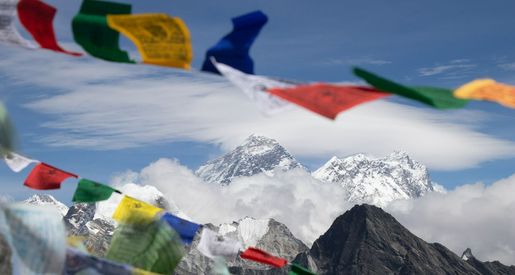- Category: Blog
Nepal's 8000m Giants
The Himalayas are a result of the collision between the Indian plate and the Eurasian plate that began somewhere around 50 million years ago in which they collided. This event created not only the Himalayas but also the Tibetan Plateau and these combined are one of the most extreme expressions of mountain building on the planet in the last 500 million years. Nepal is the place to go as it’s the present epicentre of this uplifting event and its home to 8 out of 10 of the world’s tallest peaks. The only other 2 peaks in the top 10 are in the Karakoram of Pakistan.
To be fair, most of these 8 peaks straddle the borders of India and China but however you look at it Nepal has a clear claim to housing the greatest concentration of the world’s tallest peaks not only today but probably in the last hundreds of millions of years. Everyone is familiar with Everest the world’s tallest mountain but what about the other 7 giants of Nepal.
Mount Everest (8,848m, 29,029ft)
The world’s tallest mountain was first climbed by Tenzing Norgay and Edmund Hillary in 1953 making use of the southeast ridge route which is still the most used route today. It’s still a mystery whether George Mallory reached the summit in his 1924 attempt. Mallory and Andrew “Sandy” Irvine his climbing partner were last seen in 1924 about 250m below the summit while attempting to climb the peak from the Northeast Ridge. Mallory’s body was found in 1999 but it still remains unclear whether he successfully summited the peak. Since so many people attempt to reach the summit today its common to hear people remark that Everest is a walk-up or a simple mountain to climb. The truth is that it’s still a risky proposition all-in-all since 1922 a total of 6,214 have reached the summit and 234 people have died trying. For many, climbing Everest is a lifelong dream and despite its costs and difficulties it’s likely that the number of people attempting to climb the mountain will continue to increase. In fact during the 90’s an average of 88 people made it to the summit each year and by comparison during the first decade of the current century 432 made it on average each year, a dramatic increase.
Want to see Everest with your own eyes? Check out our trek to Everest Base Camp!
Kangchenjunga (8,586m, 28,169ft)
Kangchenjunga which straddles the border between India and Nepal is the world’s 3rd tallest mountain after Everest and K2 in the Karakoram of Pakistan. The massif actually consists of five individual peaks and is frequently called the Five Treasures of Snow. Up to 1852 it was assumed that it was the worlds highest peak but new calculations by an Indian survey revealed Everest as the highest peak. The mountain is considered holy by the people of Darjeeling and Sikkim and every climber looking for the summit has actually stopped short in respect to the mountain. The “summit” was first reached by Joe Brown and George Band who were part of a British expedition. The expedition used the south base camp where the route starts from the Yalung Glacier from where the route climbs what is known as the Yalung Face a nearly vertical face of 3000m. Just getting to the south base camp takes 14 days and requires over 15000m in vertical elevation gain.
Lhotse ( 8,516m )
Lhotse is the fourth highest mountain in the world and the least summited 8000m peak in Nepal. The peak adjoins Mount Everest and raises nearly 600m above the South Col. The word Lhotse itself means “South Peak” in Tibetan and refers to the tallest of 3 peaks the other two being Lhotse Middle at 8,414m and Lhotse Shar at 8,383m. The south face is one of the steepest cliffs in the world raising 3.2km in approximately 2.5 km. In 1955 an attempt led by Norman Dyhrenfurth as part of the International Himalayan Expedition which was assisted by over 200 porters reached 8100m. Lhotse Middle was in fact the last highest unclimbed point on the planet until it was summited in 2001 by a Russian team. In total the summit has been climbed 371 times.
Makalu ( 8,462m )
Makalu is the worlds fifth highest peak and lies 22km from Everest in the Khumbu region. The peak is known for its perfect pyramid shape and its sharp ridges and steep angles make it a difficult climb. Just getting to the Makalu base camp is a nine day trek from the small airstrip of Tumlingtar. Climbing groups must be self sufficient the entire way from Kathmandu and only 206 ascents of the summit have been made which is less than most of the other 8000m peaks.
Cho Oyu ( 8,201m )
Cho Oyo is the world’s sixth highest mountain and its name means “Turquoise Goddess” in Tibetan. The mountain which is roughly 20km from Everest was first climbed in 1954 by Austrian expedition led by Herbert Tichy, Joseph Jöchler. The mountain is rarely climbed from the Nepal side and the typical route is from the Tibetan side. The mountain is typically considered one of the easier 8000m peaks but in reality no 8000m peak is easy and each carries with it the risk of death.
Dhaulagiri ( 8,167m )
Dhaulagiri means “White Mountain” in Sanskrit. Perhaps it obtained the name as its one of the few 8000m peaks that’s clearly visible from the hot plains of India. It was considered the world’s highest mountain between 1808 and 1838 until surveys indicated that Kangchenjunga was in fact higher and then in 1858 it dropped even further on the list when Everest was identified as the world’s tallest peak. It was first climbed in 1960 by a Swiss-Austrian team taking the Northeast Ridge which is the normal route. The mountain gains nearly 7,000 m (22,970 ft) from the Kali Gandaki River just 30 km away. Disaster struck in 1969 when a massive avalanche swept away 10 people of an 11 man team led by an American, Boyd Everett.
Manaslu ( 8,156m )
If Everest belongs to the British and Annapurna to the French then Mansalu the world’s eight highest peak belongs to the Japanese. The mountain was first climbed in 1956 by Toshio Imanishi and Gyalzen Norbu part of a Japanese expedition. The mountain has been struck by both tragedy and controversy and sometimes both at the same time. An avalanche killed 18 and destroyed the Pung-gyen Monastery after the first Japanese attempt in 1952. The subsequent expedition in 1954 was blamed for this tragedy and hostility from villagers forced the climbers to give up until another attempt could be made in 1956. No other climber reached the summit until 1971 when another Japanese team lead by Kazuharu Kohara and Motoki reached the summit. In 1972, a Korean expedition suffered with 15 fatalities from a huge avalanche. It’s the 4th most deadly of the 8000m peaks behind only K2, Nanga Parbet, and Annapurna
Previous Articles
- How to Train for the Everest Base Camp Trek
- How high is Everest Base Camp?
- How much spending money do you need for the Everest Base Camp trek
- What's the accommodation like on an Everest Base Camp trek
- Are showers available on the Everest Base Camp trek?
- What type of toilets are available on an Everest Base Camp Trek






